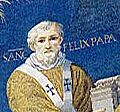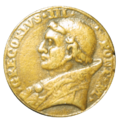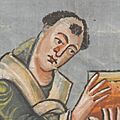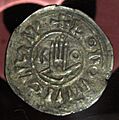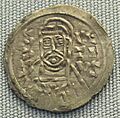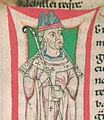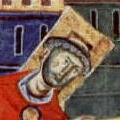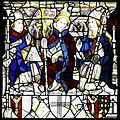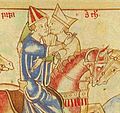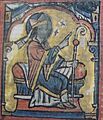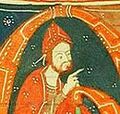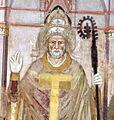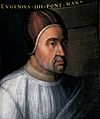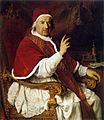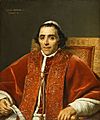List of popes facts for kids
The leader of the Catholic Church is called the Pope. The word "pope" comes from the Latin word papa, which means "father." The Pope has many important titles, like Summus Pontifex (Supreme Pontiff) and Servus servorum Dei (Servant of the servants of God).
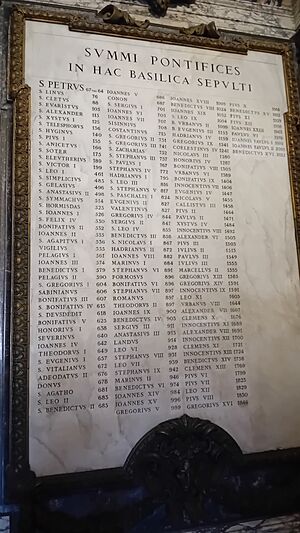
The list of popes comes from the Annuario Pontificio, an official book published by the Church every year. It includes all the leaders recognized as true popes and points out others who were considered antipopes (rival claimants to the papacy).
Keeping track of the popes has been a long process. Over the years, the list has been corrected. For example, a man named Christopher was once thought to be a real pope but was later removed. Also, a pope-elect named Stephen was removed from the list in 1961 because he died before he could officially become pope.
Many popes on this list are considered saints. This includes 48 of the first 50 popes. Out of the first 31 popes, 28 were martyrs, meaning they died for their faith.
Contents
- Popes Through History
- Popes from Religious Orders
- Why are the numbers of some popes confusing?
- Images for kids
- See also
Popes Through History
This list shows the popes in the order they served. For the first few centuries, the exact dates are hard to know for sure. The information becomes more certain after the year 222.
Early Popes: 1st to 4th Centuries
The earliest lists of popes were written much later. The first clear dates we have are for the elections of Urban I (222 AD) and Liberius (235 AD).
1st Century Popes
- St Peter (circa 30 – circa 64): Born Shimon, son of Yonah. He was an Apostle of Jesus. Catholic tradition says he was the first bishop of Rome and thus the first pope. St. Peter's Basilica is named after him.
- St Linus (circa 64 – circa 76): The first Roman pope. His feast day is September 23.
- St Cletus (circa 76 – circa 88): The first Greek pope. His feast day is April 26.
- St Clement I (circa 88 – circa 97): A Roman citizen. He was an early Christian leader and died as a martyr.
- St Evaristus (circa 97 – circa 105): A Hellenized Jew. He is said to have divided Rome into parishes.
2nd Century Popes
- St Alexander I (circa 105 – circa 115): He started the custom of blessing houses with holy water.
- St Sixtus I (circa 115 – circa 125): A Roman of Greek background.
- St Telesphorus (circa 125 – circa 136): He was called a great martyr by St. Irenaeus.
- St Hyginus (circa 136 – circa 140): A Greek. Tradition says he was martyred.
- St Pius I (circa 140 – circa 155): He decided that Easter should always be celebrated on a Sunday.
- St Anicetus (circa 155 – 166/7): The first Syrian pope. He said that priests should not have long hair.
- St Soter (166/7 – 174/5): He said that marriage was a sacrament blessed by a priest.
- St Eleutherius (174/5 – 189): A Greek.
- St Victor I (189 – 198/9): The first pope born in Africa.
- St Zephyrinus (198/9 – 20 December 217): He fought against certain false teachings.
- Natalius (circa 198/9 – circa 199/200): A rival to Pope Zephyrinus. He later made peace with the Church.
3rd Century Popes
- St Callixtus I (218 – 14 October 222): He was martyred.
- St Hippolytus (217 – 235): A rival to several popes. He later made peace with Pope Pontian.
- St Urban I (222 – 19 May 230): His feast day is May 25.
- St Pontian (21 July 230 – 28 September 235): He was the first pope to step down from his role because he was exiled. This is the earliest exact date in papal history.
- St Anterus (21 November 235 – 3 January 236): His feast day is January 3.
- St Fabian (10 February 236 – 20 January 250): He divided Rome into seven church districts.
- St Cornelius (March 251 – June 253): He died as a martyr due to great hardship.
- Novatian (March 251 – 258): He started a religious group called Novatianism. He was a rival to several popes.
- St Lucius I (25 June 253 – 5 March 254): His feast day is March 5.
- St Stephen I (12 March 254 – 2 August 257): He was martyred by beheading.
- St Sixtus II (31 August 257 – 6 August 258): He was martyred by beheading.
- St Dionysius (22 July 259 – 27 December 268): His feast day is December 26.
- St Felix I (5 January 269 – 30 December 274): His feast day is December 30.
- St Eutychian (4 January 275 – 7 December 283): His feast day is December 8.
- St Caius (17 December 283 – 22 April 296): He was martyred by beheading.
- St Marcellinus (30 June 296 – 25 October 304): His feast day is April 26.
4th Century Popes
- St Marcellus I (27 May 308 – 16 January 309): He was sent away from Rome by Emperor Maxentius and died in exile.
- St Eusebius (18 April 309 – 17 August 310): He was sent away by Emperor Maxentius and died in exile.
- St Miltiades (2 July 311 – 10 January 314): He was the first pope after Christians were allowed to practice their faith freely.
- St Sylvester I (31 January 314 – 31 December 335): He was pope during the First Council of Nicaea (325), an important meeting for the Church.
- St Mark (18 January 336 – 7 October 336): He collected stories of martyrs and bishops.
- St Julius I (6 February 337 – 12 April 352): He supported Athanasius of Alexandria in a debate about Christian beliefs.
- Liberius (17 May 352 – 24 September 366): He was sent away by an emperor who favored a different Christian belief.
- Felix II (355 – 22 November 365): A rival to Pope Liberius, put in place by the emperor.
- St Damasus I (1 October 366 – 11 December 384): He was the first pope from what is now Portugal. He asked Jerome to translate the Bible into Latin.
- Ursinus (1 October 366 – 16 November 367): A rival to Pope Damasus I.
- St Siricius (17 December 384 – 26 November 399): His letters are the earliest surviving papal decrees. He issued the first rule for priests to remain unmarried.
- St Anastasius I (27 November 399 – 19 December 401): He told priests to bow their heads when reading from the Gospels.
Popes in the Middle Ages: 5th to 10th Centuries
5th Century Popes
- St Innocent I (21 December 401 – 12 March 417): Rome was attacked by the Visigoths in 410 during his time.
- St Zosimus (18 March 417 – 26 December 418): His feast day is December 27.
- Eulalius (27 December 418 – 3 April 419): A rival to Pope Boniface I.
- St Boniface I (28 December 418 – 4 September 422): His feast day is October 25.
- St Celestine I (10 September 422 – 27 July 432): He was pope during the Council of Ephesus (431).
- St Sixtus III (31 July 432 – 18 August 440): His feast day is March 28.
- St Leo I ("the Great") (29 September 440 – 10 November 461): He convinced Attila the Hun to turn back from invading Italy. He also convinced the Vandals to spare the lives of the people of Rome during their attack.
- St Hilarius (19 November 461 – 29 February 468): His feast day is February 28.
- St Simplicius (3 March 468 – 10 March 483): He was pope during the fall of the Western Roman Empire.
- St Felix III (13 March 483 – 1 March 492): He was the great-great-grandfather of Gregory I.
- St Gelasius I (1 March 492 – 21 November 496): The last pope born in Africa. He was the first pope called the Vicarius Christi (Vicar of Christ).
- Anastasius II (24 November 496 – 19 November 498): He tried to end a Church division.
- St Symmachus (22 November 498 – 19 July 514): His feast day is July 19.
- Laurentius (22 November 498 – Aug 506/8): A rival to Pope Symmachus.
6th Century Popes
- St Hormisdas (20 July 514 – 6 August 523): He was the father of Silverius.
- St John I (13 August 523 – 18 May 526): His feast day is May 18.
- St Felix IV (12 July 526 – 22 September 530): He built the church of Santi Cosma e Damiano.
- Boniface II (22 September 530 – 17 October 532): The first pope of Germanic background. He changed how years were numbered in the calendar, from Anno Martyrum to Anno Domini.
- Dioscorus (22 September 530 – 14 October 530): A rival to Pope Boniface II. He died less than a month after his election.
- John II (2 January 533 – 8 May 535): He was the first pope not to use his birth name, as it was linked to the Roman god Mercury.
- St Agapetus I (13 May 535 – 22 April 536): His feast days are April 22 and September 20.
- St Silverius (8 June 536 – 11 March 537): He was exiled. He was the son of Hormisdas.
- Vigilius (29 March 537 – 7 June 555): He was pope during the Second Council of Constantinople (553).
- Pelagius I (16 April 556 – 4 March 561): He is credited with building the basilica of Santi Apostoli.
- John III (17 July 561 – 13 July 574): He was the second pope not to use his birth name.
- Benedict I (2 June 575 – 30 July 579): A Roman.
- Pelagius II (26 November 579 – 7 February 590): He ordered the building of the Basilica di San Lorenzo fuori le Mura.
- St Gregory I ("the Great") (3 September 590 – 12 March 604): He was the great-great-grandson of Felix III. He was the first pope to formally use the titles Pontifex Maximus and Servus servorum Dei. He established the Gregorian chant.
7th Century Popes
- Sabinian (13 September 604 – 22 February 606): For the next two centuries, Roman popes were influenced by the (Eastern) Roman Empire.
- Boniface III (19 February 607 – 12 November 607): Of Greek background.
- St Boniface IV (15 September 608 – 8 May 615): He was the first pope to have the same name as his immediate predecessor.
- St Adeodatus I (13 November 615 – 8 November 618): He was the first pope to use lead seals on papal documents, which became known as papal bulls.
- Boniface V (23 December 619 – 25 October 625): A Roman.
- Honorius I (27 October 625 – 12 October 638): He was later declared a heretic by a Church council.
- Severinus (28 May 640 – 2 August 640): A Roman.
- John IV (24 December 640 – 12 October 642): A Roman.
- Theodore I (24 November 642 – 14 May 649): He was the last pope from Palestine.
- St Martin I (5 July 649 – 16 September 655): He was the last pope recognized as a martyr.
- St Eugene I (10 August 654 – 2 June 657): His feast day is June 2.
- St Vitalian (30 July 657 – 27 January 672): His feast day is January 27.
- Adeodatus II (11 April 672 – 17 June 676): He was a member of the Order of Saint Benedict.
- Donus (2 November 676 – 11 April 678): A Roman.
- St Agatho (27 June 678 – 10 January 681): He was pope during the Third Council of Constantinople (680).
- St Leo II (17 August 682 – 3 July 683): His feast day is July 3.
- St Benedict II (26 June 684 – 8 May 685): His feast day is May 7.
- John V (23 July 685 – 2 August 686): Of Greek background.
- Conon (21 October 686 – 21 September 687): Of Greek background.
- St Sergius I (15 December 687 – 8 September 701): He introduced the singing of the Lamb of God at Mass.
8th Century Popes
- John VI (30 October 701 – 11 January 705): He was the only pope from Asia Minor.
- John VII (1 March 705 – 18 October 707): He was the second pope to have the same name as his immediate predecessor.
- Sisinnius (15 January 708 – 4 February 708): Of Syrian background.
- Constantine (25 March 708 – 9 April 715): He was the last pope to visit Greece while in office until John Paul II in 2001.
- St Gregory II (19 May 715 – 11 February 731): He held an important meeting in Rome in 721.
- St Gregory III (18 March 731 – 28 November 741): The last pope from Syria. He was also the last pope born outside Europe until Francis in 2013.
- St Zachary (3 December 741 – 22 March 752): He built the church of Santa Maria sopra Minerva.
- Stephen (II) (23 March 752 – 26 March 752): He died three days after being chosen, before he could become a bishop. He is no longer considered a pope by the Catholic Church.
- Stephen II (26 March 752 – 26 April 757): He was sometimes called Stephen III. He was the brother of Paul I.
- St Paul I (29 May 757 – 28 June 767): He was the brother of Stephen II.
- Stephen III (7 August 768 – 24 January 772): He called an important meeting in Rome in 769.
- Adrian I (1 February 772 – 26 December 795): He was pope during the Second Council of Nicaea (787).
- St Leo III (26 December 795 – 12 June 816): He crowned Emperor Charlemagne on Christmas Day in 800, which began the Holy Roman Empire.
9th Century Popes
- Stephen IV (22 June 816 – 24 January 817): The first pope born in Rome after the Church broke away from the Eastern Roman Empire.
- St Paschal I (25 January 817 – 11 February 824): He is credited with finding the body of Saint Cecilia and building churches.
- Eugene II (6 June 824 – 27 August 827): A Roman.
- Valentine (31 August 827 – 10 October 827): A Roman.
- Gregory IV (20 December 827 – 25 January 844): He rebuilt parts of St. Peter's Basilica.
- Sergius II (25 January 844 – 27 January 847): A Roman.
- St Leo IV (10 April 847 – 17 July 855): Of Lombard background.
- Benedict III (29 September 855 – 17 April 858): A Roman.
- St Nicholas I ("the Great") (24 April 858 – 13 November 867): He encouraged Christian missionaries.
- Adrian II (14 December 867 – 14 December 872): He was pope during the Fourth Council of Constantinople (869–870).
- John VIII (14 December 872 – 16 December 882): He was the first pope to be assassinated.
- Marinus I (16 December 882 – 15 May 884): He was sometimes mistakenly called Martin II.
- St Adrian III (17 May 884 – 8 July 885): His feast day is July 8.
- Stephen V (September 885 – 14 September 891): He was sometimes called Stephen VI.
- Formosus (6 October 891 – 4 April 896): He was later put on trial after his death by Stephen VI.
- Boniface VI (11 April 896 – 26 April 896): A Roman.
- Stephen VI (22 May 896 – 14 August 897): He held a very unusual trial of a dead pope.
- Romanus (14 August 897 – November 897): A Roman.
- Theodore II (December 897 – 20 December 897): Of Greek background.
- John IX (18 January 898 – 5 January 900): Of Lombard background.
- Benedict IV (1 February 900 – 30 July 903): A Roman.
10th Century Popes
- Leo V (30 July 903 – December 903): He was removed from office and died.
- Christopher (October 903 – January 904): A rival to Pope Leo V.
- Sergius III (29 January 904 – 14 April 911): He was the first pope shown wearing the papal tiara.
- Anastasius III (14 April 911 – June 913): A Roman.
- Lando (7 July 913 – 5 February 914): He was the last pope to use a new and unique name until Francis in 2013.
- John X (March 914 – 28 May 928): A Roman.
- Leo VI (28 May 928 – February 929): A Roman.
- Stephen VII (3 February 929 – 13 February 931): He was sometimes called Stephen VIII.
- John XI (15 March 931 – December 935): He was likely the son of Sergius III.
- Leo VII (3 January 936 – 13 July 939): He was a member of the Order of Saint Benedict.
- Stephen VIII (14 July 939 – 30 October 942): He was sometimes called Stephen IX.
- Marinus II (30 October 942 – 1 May 946): He was sometimes mistakenly called Martin III.
- Agapetus II (10 May 946 – 8 November 955): A Roman.
- John XII (16 December 955 – 6 December 963): He was the third pope not to use his birth name. He crowned Emperor Otto I in 962.
- Leo VIII (6 December 963 – 26 February 964): He was chosen by Emperor Otto I as a rival to Pope John XII. The Catholic Church today does not consider his time as pope during this period to be legitimate.
- John XII (26 February 964 – 14 May 964): He might have been murdered in 964.
- Benedict V (22 May 964 – 23 June 964): He was chosen by the people of Rome as a rival to Pope Leo VIII. He later accepted his removal from office.
- Leo VIII (23 June 964 – 1 March 965): His time as pope after the removal of Pope Benedict V is considered legitimate by the Catholic Church today.
- John XIII (1 October 965 – 6 September 972): He was known as "the Good" after his death.
- Benedict VI (19 January 973 – 8 June 974): He was removed from office and died.
- Boniface VII (July 974 – July 974): He was a rival to popes Benedict VI and Benedict VII.
- Benedict VII (October 974 – 10 July 983): A Roman.
- John XIV (December 983 – 20 August 984): He was the fourth pope not to use his birth name.
- Boniface VII (20 August 984 – 20 July 985): He was a rival to popes John XIV and John XV.
- John XV (20 August 985 – 1 April 996): He was the first pope to officially declare someone a saint.
- Gregory V (3 May 996 – 18 February 999): The first official German pope. He was the fifth pope not to use his birth name, a practice that became a tradition.
- John XVI (April 997 – February 998): A rival to Pope Gregory V.
- Sylvester II (2 April 999 – 12 May 1003): The first French pope.
Popes in the High Middle Ages: 11th to 12th Centuries
11th Century Popes
- John XVII (16 May 1003 – 6 November 1003): A Roman.
- John XVIII (25 December 1003 – 18 July 1009): He was the first pope born after the Papal States became part of the Holy Roman Empire.
- Sergius IV (31 July 1009 – 12 May 1012): He was a member of the Order of Saint Benedict.
- Gregory VI (12 June 1012 – 31 December 1012): A rival to Pope Benedict VIII. He was removed from Rome.
- Benedict VIII (18 May 1012 – 9 April 1024): He was the brother of John XIX.
- John XIX (14 May 1024 – 6 October 1032): He was the brother of Benedict VIII.
- Benedict IX (21 October 1032 – 31 December 1044): This was his first time as pope. He was the youngest person to become pope.
- Sylvester III (13 January 1045 – 10 March 1045): His election was questioned, and he was removed from office.
- Benedict IX (10 March 1045 – 1 May 1045): This was his second time as pope. He was removed from office.
- Gregory VI (1 May 1045 – 20 December 1046): He was removed from office.
- Clement II (24 December 1046 – 9 October 1047): He was chosen by King Henry III.
- Benedict IX (8 November 1047 – 17 July 1048): This was his third time as pope. He was removed from office.
- Damasus II (17 July 1048 – 9 August 1048): A German.
- St Leo IX (12 February 1049 – 19 April 1054): In 1054, actions during his time led to the East–West Schism, a major split between the Eastern and Western Churches.
- Victor II (13 April 1055 – 28 July 1057): A German.
- Stephen IX (2 August 1057 – 29 March 1058): He was the last German pope until Benedict XVI (2005–2013).
- Benedict X (4 April 1058 – 24 January 1059): A rival to Pope Nicholas II. He was captured and removed from office.
- Nicholas II (6 December 1058 – 27 July 1061): He stated that only the College of Cardinals could elect the pope.
- Honorius II (30 September 1061 – 1072): A rival to Pope Alexander II.
- Alexander II (30 September 1061 – 21 April 1073): He allowed the Norman conquest of England.
- St Gregory VII (22 April 1073 – 25 May 1085): He started the Gregorian Reforms. He had a political struggle with Emperor Henry IV.
- Clement III (25 June 1080 – 8 September 1100): He was a rival to several popes.
- Bl. Victor III (24 May 1086 – 16 September 1087): He was a member of the Order of Saint Benedict.
- Bl. Urban II (12 March 1088 – 29 July 1099): He preached and started the First Crusade.
- Paschal II (13 August 1099 – 21 January 1118): He ordered the building of the basilica of Santi Quattro Coronati.
- Theodoric (8 September 1100 – January 1101): A rival to Pope Paschal II. He was captured and sent to a monastery.
12th Century Popes
- Adalbert (January 1101 – February 1102): A rival to Pope Paschal II. He was captured and imprisoned.
- Sylvester IV (8 November 1105 – 11 April 1111): A rival to Pope Paschal II. He was forced to step down.
- Gelasius II (24 January 1118 – 29 January 1119): He was a member of the Order of Saint Benedict.
- Gregory VIII (10 March 1118 – 20 April 1121): A rival to popes Gelasius II and Callixtus II. He was captured and imprisoned.
- Callixtus II (2 February 1119 – 13 December 1124): He called the First Council of the Lateran (1123).
- Celestine II (16 December 1124 – 17 December 1124): He was a rival to Pope Honorius II. He stepped down one day after being chosen.
- Honorius II (21 December 1124 – 13 February 1130): He approved the Knights Templar as a military order in 1128.
- Innocent II (14 February 1130 – 24 September 1143): He called the Second Council of the Lateran (1139).
- Anacletus II (14 February 1130 – 25 January 1138): He was a rival to Pope Innocent II.
- Victor IV (15 March 1138 – 29 May 1138): A rival to Pope Innocent II.
- Celestine II (26 September 1143 – 8 March 1144): A Roman.
- Lucius II (12 March 1144 – 15 February 1145): A Roman.
- Bl. Eugene III (15 February 1145 – 8 July 1153): He announced the Second Crusade.
- Anastasius IV (12 July 1153 – 3 December 1154): A Roman.
- Adrian IV (4 December 1154 – 1 September 1159): The only English pope.
- Alexander III (7 September 1159 – 30 August 1181): He called the Third Council of the Lateran (1179).
- Victor IV (7 September 1159 – 20 April 1164): A rival to Pope Alexander III.
- Paschal III (28 April 1164 – 22 September 1168): A rival to Pope Alexander III.
- Callixtus III (30 September 1168 – 29 August 1178): A rival to Pope Alexander III.
- Innocent III (29 September 1179 – January 1180): A rival to Pope Alexander III. He was captured and imprisoned.
- Lucius III (1 September 1181 – 25 November 1185): A Roman.
- Urban III (25 November 1185 – 20 October 1187): Of Italian background.
- Gregory VIII (21 October 1187 – 17 December 1187): He suggested the Third Crusade.
- Clement III (19 December 1187 – 20 March 1191): A Roman.
- Celestine III (30 March 1191 – 8 January 1198): He confirmed the rules for the Teutonic Knights, a military order.
- Innocent III (8 January 1198 – 16 July 1216): He called the Fourth Council of the Lateran (1215). He started the Fourth Crusade but later distanced himself from it. He also supported the Franciscan Order.
Popes in the Late Middle Ages: 13th to 14th Centuries
13th Century Popes
- Honorius III (18 July 1216 – 18 March 1227): He started the Fifth Crusade. He also approved several religious orders.
- Gregory IX (19 March 1227 – 22 August 1241): He started the inquisition in France and supported the Northern Crusades.
- Celestine IV (25 October 1241 – 10 November 1241): He died before he could be crowned.
- Innocent IV (25 June 1243 – 7 December 1254): He called the First Council of Lyon (1245).
- Alexander IV (12 December 1254 – 25 May 1261): He was the first pope born after the Papal States became independent in 1177. He brought back the papal inquisition in France.
- Urban IV (29 August 1261 – 2 October 1264): He started the feast of Corpus Christi in 1264.
- Clement IV (5 February 1265 – 29 November 1268): A French pope.
- Interregnum (29 November 1268 – 1 September 1271): There was almost a three-year period without a pope because cardinals could not agree on a choice.
- Bl. Gregory X (1 September 1271 – 10 January 1276): He called the Second Council of Lyon and set rules for how popes should be elected.
- Bl. Innocent V (21 January 1276 – 22 June 1276): He was the first pope chosen in a conclave (a meeting of cardinals to elect a pope).
- Adrian V (11 July 1276 – 18 August 1276): He changed the rules for papal elections.
- John XXI (8 September 1276 – 20 May 1277): He was from Portugal. The number XX was skipped in his name due to a mistake in counting previous popes named John.
- Nicholas III (25 November 1277 – 22 August 1280): A Roman.
- Martin IV (22 February 1281 – 28 March 1285): He was from France.
- Honorius IV (2 April 1285 – 3 April 1287): A Roman.
- Nicholas IV (22 February 1288 – 4 April 1292): He ordered the creation of the Vatican Archives. He also allowed the Spanish Inquisition to begin.
- Interregnum (4 April 1292 – 5 July 1294): There was a two-year period without a pope because cardinals could not agree on a choice.
- St Celestine V (5 July 1294 – 13 December 1294): He was the last pope to step down from his role on his own until Benedict XVI in 2013.
- Boniface VIII (24 December 1294 – 11 October 1303): He made the rules for papal elections official. He also formalized the jubilee (1300).
14th Century Popes
- Bl. Benedict XI (22 October 1303 – 7 July 1304): He reversed some of the strong statements made by the previous pope.
- Clement V (5 June 1305 – 20 April 1314): He moved the papacy to Avignon in 1309. He called the Council of Vienne (1311–1312).
- Interregnum (20 April 1314 – 7 August 1316): There was a two-year period without a pope because cardinals could not agree on a choice.
- John XXII (7 August 1316 – 4 December 1334): He was from France and was pope in Avignon. He had some controversial views on religious matters.
- Nicholas V (12 May 1328 – 25 July 1330): A rival to Pope John XXII. He later submitted to John XXII.
- Benedict XII (20 December 1334 – 25 April 1342): He was from France and was pope in Avignon. He was known for reforming monastic orders.
- Clement VI (7 May 1342 – 6 December 1352): He was from France and was pope in Avignon. He was pope during the Black Death and offered forgiveness for sins to those who died from it.
- Innocent VI (18 December 1352 – 12 September 1362): He was from France and was pope in Avignon. He helped bring about a peace treaty.
- Bl. Urban V (28 September 1362 – 19 December 1370): He was from France and was pope in Avignon. He improved education and sent missionaries.
- Gregory XI (30 December 1370 – 27 March 1378): He moved the papacy back to Rome in 1377. He was the last French pope.
- Urban VI (8 April 1378 – 15 October 1389): He was the last pope chosen from outside the College of Cardinals. He was pope during the Western Schism, a time when there were multiple people claiming to be pope.
- Clement VII (20 September 1378 – 16 September 1394): He was a rival pope during the Western Schism.
- Boniface IX (2 November 1389 – 1 October 1404): He was pope during the Western Schism.
- Benedict XIII (28 September 1394 – 23 May 1423): He was a rival pope during the Western Schism. He was excommunicated in 1417.
Popes in the Renaissance: 15th to 16th Centuries
15th Century Popes
- Innocent VII (17 October 1404 – 6 November 1406): He was pope during the Western Schism.
- Gregory XII (30 November 1406 – 4 July 1415): He was pope during the Western Schism. He agreed to step down to help end the schism. He was the last pope to step down until Benedict XVI in 2013.
- Alexander V (30 June 1409 – 3 May 1410): He was a rival pope during the Western Schism. He was considered a legitimate pope until 1963.
- John XXIII (25 May 1410 – 29 May 1415): He was a rival pope during the Western Schism. He was removed from office. He was considered a legitimate pope until 1958.
- Interregnum (4 July 1415 – 11 November 1417): There was a two-year period without a pope. The Council of Constance worked to end the Western Schism.
- Martin V (11 November 1417 – 20 February 1431): His election effectively ended the Western Schism. He started the Hussite Wars.
- Clement VIII (10 June 1423 – 26 July 1429): He was a rival pope during the Western Schism. He later submitted to Martin V.
- Benedict XIV (1424 – 1429): He was one of two rival popes.
- Benedict XIV (1430 – 1437): He was one of two rival popes.
- Eugene IV (3 March 1431 – 23 February 1447): He crowned Emperor Sigismund in Rome in 1433. He also issued a papal order protecting the people of the Canary Islands from being enslaved if they became Christians.
- Felix V (5 November 1439 – 7 April 1449): He was a rival to popes Eugene IV and Nicholas V. He later submitted to Nicholas V.
- Nicholas V (6 March 1447 – 24 March 1455): He held the 1450 jubilee. He also started a library in the Vatican, which became the Vatican Library.
- Callixtus III (8 April 1455 – 6 August 1458): He ordered a new trial for Joan of Arc, which cleared her name.
- Pius II (19 August 1458 – 15 August 1464): He was interested in city planning and founded the ideal city of Pienza.
- Paul II (30 August 1464 – 26 July 1471): He built the Palazzo San Marco in Rome. He also approved the use of printing in the Papal States.
- Sixtus IV (9 August 1471 – 12 August 1484): He ordered the building of the Sistine Chapel and created the Vatican Archives. He was a great supporter of the arts.
- Innocent VIII (29 August 1484 – 25 July 1492): He appointed a leader for the Spanish Inquisition.
- Alexander VI (11 August 1492 – 18 August 1503): He divided the newly explored world between Spain and Portugal. He is known as one of the most discussed popes of the Renaissance period.
16th Century Popes
- Pius III (22 September 1503 – 18 October 1503): He was the nephew of Pius II. He founded the Piccolomini Library.
- Julius II (31 October 1503 – 21 February 1513): He was nicknamed the "Warrior Pope." He started the Vatican Museums and the rebuilding of St. Peter's Basilica. He also organized the famous Swiss Guard for his protection.
- Leo X (9 March 1513 – 1 December 1521): He is remembered for allowing people to donate money to the Church for the rebuilding of St. Peter's Basilica. He also excommunicated Martin Luther in 1521.
- Adrian VI (9 January 1522 – 14 September 1523): He was the only Dutch pope. He tried to reform the Catholic Church in response to the Protestant Reformation.
- Clement VII (26 November 1523 – 25 September 1534): Rome was attacked by imperial troops in 1527 during his time. He did not allow King Henry VIII of England to divorce.
- Paul III (13 October 1534 – 10 November 1549): He recognized the Jesuits in 1540. He opened the Council of Trent (1545), a very important meeting for the Catholic Church.
- Julius III (7 February 1550 – 29 March 1555): He reopened the Council of Trent in 1551.
- Marcellus II (9 April 1555 – 1 May 1555): He was the last pope to use his birth name as his papal name.
- Paul IV (23 May 1555 – 18 August 1559): He established the Roman Ghetto and published a list of forbidden books.
- Pius IV (26 December 1559 – 9 December 1565): He reopened and closed the Council of Trent (1563).
- St Pius V (7 January 1566 – 1 May 1572): He excommunicated Queen Elizabeth I of England. He also issued an important Roman Missal in 1570.
- Gregory XIII (13 May 1572 – 10 April 1585): He reformed the calendar in 1582, creating the Gregorian calendar we use today.
- Sixtus V (24 April 1585 – 27 August 1590): He completed many building projects in Rome. He also set the number of cardinals to 70.
- Urban VII (15 September 1590 – 27 September 1590): He was the shortest-reigning pope. He died before he could be crowned. He set the first known worldwide ban on smoking in or near churches.
- Gregory XIV (5 December 1590 – 16 October 1591): He made gambling on papal elections punishable by excommunication to keep the process fair.
- Innocent IX (29 October 1591 – 30 December 1591): He supported the King of Spain and the Catholic League in France.
- Clement VIII (30 January 1592 – 3 March 1605): He started an alliance of Christian powers to fight against the Ottoman Empire.
Popes in the Modern Era: 17th to 21st Centuries
17th Century Popes
- Leo XI (1 April 1605 – 27 April 1605): He was called the "Lightning Pope" because his time as pope was very short.
- Paul V (16 May 1605 – 28 January 1621): He was known for funding many building projects, including the front of St. Peter's Basilica.
- Gregory XV (9 February 1621 – 8 July 1623): He made it a rule for papal elections to be by secret ballot. He also established the Congregation for the Propagation of the Faith to spread Christianity.
- Urban VIII (6 August 1623 – 29 July 1644): He was involved in the trial against Galileo Galilei.
- Innocent X (15 September 1644 – 7 January 1655): He built the Fontana dei Quattro Fiumi in Rome.
- Alexander VII (7 April 1655 – 22 May 1667): He commissioned St. Peter's Square.
- Clement IX (20 June 1667 – 9 December 1669): He helped mediate a peace treaty.
- Clement X (29 April 1670 – 22 July 1676): He made St Rose of Lima the first saint from the Americas in 1671.
- Bl. Innocent XI (21 September 1676 – 12 August 1689): He started the Holy League.
- Alexander VIII (6 October 1689 – 1 February 1691): A Venetian.
- Innocent XII (12 July 1691 – 27 September 1700): He issued a rule to stop favoritism (nepotism). He also built many charities and schools.
- Clement XI (23 November 1700 – 19 March 1721): He supported the first archaeological digs in the Roman catacombs.
18th Century Popes
- Innocent XIII (8 May 1721 – 7 March 1724): He stopped the Jesuits from continuing their mission in China.
- Servant of God Benedict XIII (29 May 1724 – 21 February 1730): He lifted the worldwide ban on smoking.
- Clement XII (12 July 1730 – 6 February 1740): He commissioned the Trevi Fountain in Rome (1732). He also condemned Freemasonry.
- Benedict XIV (17 August 1740 – 3 May 1758): He reformed the education of priests and the calendar of feasts. He allowed the publication of Galileo's scientific works.
- Clement XIII (6 July 1758 – 2 February 1769): He added fig leaves to nude statues in the Vatican. He defended the Jesuits.
- Clement XIV (19 May 1769 – 22 September 1774): He suppressed the Jesuits in 1773.
- Pius VI (15 February 1775 – 29 August 1799): He spoke out against the French Revolution. He was removed from the Papal States by the French and died a prisoner.
- Interregnum (29 August 1799 – 14 March 1800): There was a six-month period without a pope due to difficult circumstances.
- Servant of God Pius VII (14 March 1800 – 20 August 1823): He was present at Napoleon's coronation as emperor. He brought back the Jesuits in 1814.
19th Century Popes
- Leo XII (28 September 1823 – 10 February 1829): He put Catholic education under the control of the Jesuits.
- Pius VIII (31 March 1829 – 30 November 1830): He accepted Louis Philippe I as King of the French.
- Gregory XVI (2 February 1831 – 1 June 1846): He was the last non-bishop to be elected pope. During his time, the Church removed all bans on works that supported the idea of the Earth revolving around the Sun.
- Bl. Pius IX (16 June 1846 – 7 February 1878): He defined the beliefs of the Immaculate Conception and papal infallibility. He lost the Papal States to Italy in 1870. He was the longest-reigning pope since Peter. He was the first pope to be photographed.
- Leo XIII (20 February 1878 – 20 July 1903): He was the fourth-longest reigning pope. He supported Christian democracy against Communism. He was the first pope to be filmed and have his voice recorded.
20th Century Popes
- St Pius X (4 August 1903 – 20 August 1914): He focused on the Eucharist.
- Benedict XV (3 September 1914 – 22 January 1922): He is remembered for trying to bring peace during World War I.
- Pius XI (6 February 1922 – 10 February 1939): He signed the Lateran Treaty with Italy in 1929, which created Vatican City as its own country. He also started Vatican Radio.
- Ven. Pius XII (2 March 1939 – 9 October 1958): He was the first pope born after the unification of Italy. He tried to bring peace during World War II. He published a document that took a neutral stance on human evolution.
- St John XXIII (28 October 1958 – 3 June 1963): He opened the Second Vatican Council (1962), a very important meeting for the Church. He also helped bring peace during the Cuban Missile Crisis (1962). He was known as "Good Pope John."
- St Paul VI (21 June 1963 – 6 August 1978): He was the last pope to be crowned. He was the first pope since 1809 to travel outside Italy. He closed the Second Vatican Council (1965).
- Bl. John Paul I (26 August 1978 – 28 September 1978): He was the most recent Italian pope. He died just 33 days after being elected.
- St John Paul II (16 October 1978 – 2 April 2005): He was the first pope from Poland and the first non-Italian pope since 1523. He was the third-longest reigning pope. He traveled to many countries and started World Youth Day.
21st Century Popes
- Benedict XVI (19 April 2005 – 28 February 2013): He was the first German pope since 1058. He was the first pope to step down from his role since 1415, becoming pope emeritus. He was the longest-lived pope on record, dying at 95 years old.
- Francis (13 March 2013 – 21 April 2025): He is the first pope born outside Europe since 741, and the first from the Americas. He is also the first Jesuit pope. He issued an important document about global warming. He also helped improve relations between the US and Cuba.
- Leo XIV (8 May 2025 – present): He is the first pope born in the United States and the first from North America. He is also the second pope from an English-speaking country.
Popes from Religious Orders
Many popes have come from religious orders, which are communities of men dedicated to a specific spiritual life.
- Benedictines (O.S.B.): 22 popes, including St. Gregory the Great and Urban V.
- Franciscans (O.F.M.): 5 popes, including Sixtus IV and Julius II.
- Dominicans (O.P.): 4 popes, including St. Pius V and Benedict XIII.
- Jesuits (S.J.): 1 pope, Francis.
Why are the numbers of some popes confusing?
Sometimes, the numbering of popes can be tricky. This is usually due to historical mistakes or confusion over who was a legitimate pope.
- Stephen: A man named Stephen was elected in 752 but died before he could be officially made pope. For centuries, he was called Stephen II. In 1961, the Church removed him from the official list. This is why the pope who used to be called Stephen III is now known as Stephen II.
- John: The numbering for popes named John is the most confusing. Antipope John XVI was mistakenly counted for a long time. Later, Pope John XXI skipped the number XX because he thought there had been a John XX, which was an error.
- Felix: Antipope Felix II was counted as a real pope for a long time, so the numbering includes him.
Images for kids
See also
 In Spanish: Anexo:Papas para niños
In Spanish: Anexo:Papas para niños
- Annuario Pontificio
- History of the papacy
- Index of Vatican City-related articles
- Legends surrounding the papacy
- Liber Pontificalis
- Papal name
- Papal appointment
- Pope John (numbering)
- Prophecy of the Popes
Lists
- List of canonized popes
- List of murdered popes
- List of popes by nationality
- List of popes from the Borgia family
- List of popes from the Conti family
- List of popes from the Medici family
- List of popes sorted alphabetically
- List of Sovereigns of the Vatican City State
- List of popes (graphical)


